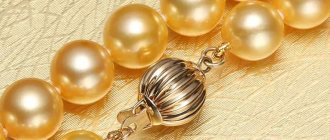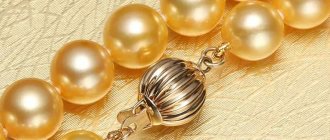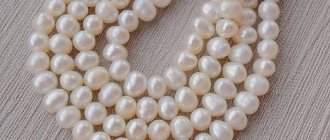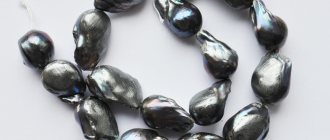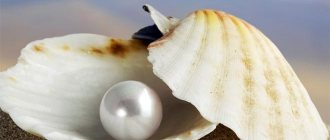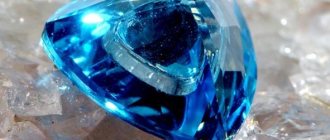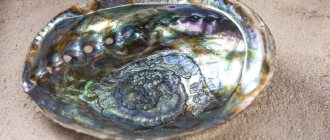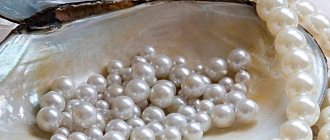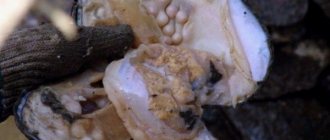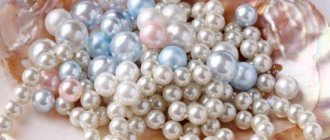Water and the caring embrace of a mollusk create a flawless creation from a grain of sand and mother-of-pearl - a pearl. However, nature is leisurely, and people want more and faster. In order to preserve a healthy ecological environment in the world, the harvesting of pearl oysters has been prohibited since 1952: that is why cultured pearls were invented.
Cultured pearls
What are cultured pearls
Cultured stone is similar in its properties and characteristics to natural pearls. However, it is produced under man-made conditions.
A distinction should be made between artificial pearls and cultured pearls. In the first case, stones are made at a factory from glass or plastic, and then coated with special dyes. This variety is not classified as a precious mineral. Artificial beads are used to create jewelry or as a decorative element.
A natural mineral is formed as a result of a foreign body entering the shell. The mollusk secretes a special secretion that envelops the traumatic agent. The result is a rounded stone. The longer the pearl stays in the shell, the larger its size. Sometimes the pearl ball grows to gigantic sizes.
Thus, a specimen weighing about 6 kg was found near the island of Palawan.
Cultured pearls are produced on special farms. Conditions identical to natural ones are created. To improve the quality of the stone, a special type of mollusk (Pinctada or Pteria) is selected. A grain of sand is placed in the shell and processed by the oyster for several years.
About the types of pearls, see a brief overview:
Saltwater cultured pearls
Saltwater cultured pearls are large in size and have an ideal core shape. In this case, a stable temperature and a certain salinity of water are important. Otherwise, the mussel will die.
Pearl is formed as a result of the introduction of a grain of sand into the reproductive apparatus of a mollusk. After just 2 years, a pearl of proper quality is formed. From 1 to 3 stones are removed from the shell.
This method is extremely dangerous for the oyster. A large proportion of mollusks die in the first year of formation. Some individuals reject the foreign body. If this does not happen, the pearl matures over the course of several years.
Freshwater river cultured pearls
The creation of freshwater cultured pearls is fundamentally different. In this case, a fragment of mother-of-pearl is placed not in the reproductive organs, but in the mantle of the mollusk. In this case, up to 20 nuclei can form in one shell.
This mineral grows in fresh water or in flooded rice fields. These conditions are most favorable for mollusks. They contribute to their growth, development, and reproduction.
The price of river stone is lower. Most minerals are small in diameter and irregular in shape.
Read about natural freshwater pearls here.
View this post on Instagram
Publication from JEWELRY? EARRINGS?BRACELETS (@nastasia_olesandr) May 21, 2021 at 10:34 PDT
Pearl cultivation methods
There are two main methods of growing pearls:
- Nuclear-free way. It is an inexpensive method that is widely used during the cultivation of freshwater pearls.
- Nuclear method. With this method, a seed (core) is placed into the shell. This extraction option is used to create marine pearl culture.
Nuclear method
So how does this happen? First there is a donor pearl oyster. As a rule, this is a young mollusk with a good mantle (the so-called nacreous shell). At the same time, attention is paid to the quality of development of the gonad (reproductive gland secreted by mother of pearl) that the oyster has.
The pearl in it is formed in this way. The shell with the pearl oyster is opened slightly using pliers, then the real operation takes place: a small incision is made in very soft tissue with special instruments, where a graft is installed - a piece of the donor's mantle. A small ball is placed near it, which is removed from a bivalve freshwater oyster. Then the pearl mussel goes back to the lagoon, and spends several more years here in peace.
It should be noted that this is the most dangerous time: she may die or eject the core - the chances of this are quite high. If everything goes smoothly, then after a couple of years a pearl is formed. This pearl has a real layer of nacre of 0.3-1 mm. Moreover, a mineral of 1 centimeter is formed in a year. At a stretch, these pearls can be called natural. If you pick it up, it immediately heats up, like a piece of plasticine, and even an inexperienced person will immediately be able to distinguish a weighty, cold and real stone from its weightless and easily warmed up imitator.
Nuclear-free method
The advantage of this method of cultivation is that, with a fairly small core and prolonged growth, the cultivated mineral is in no way inferior, and in some cases even surpasses natural stone in size and color. Today, almost all cultured freshwater pearls, the diameter of which is no more than 7-8 mm, are grown in this way. a small grain of nacre sand is used as the core , which is extracted directly from the shell.
In this case, the grown minerals can be marine or freshwater, it depends on the habitat of the shell.
How are pearls grown?
Growing pearls is a long and labor-intensive process.
It includes the following steps:
- introduction of a nacre fragment into the body of a mollusk;
- placing the sink in special conditions (salinity and water temperature are strictly regulated);
- growing period (lasts from 2 to 5 years);
- removing a pearl from a shell.
Farms that grow cultured pearls are located everywhere. The leadership in this matter belongs to China and Japan. The products of these countries occupy almost the entire jewelry market.
In Russia, freshwater pearls are mainly cultivated. This is due to geological and climatic features. However, its cost is higher than in China, so it is not profitable to engage in pearl production.
There are opinions that the process of growing pearls is simple and can be done at home.
In China you can even buy shellfish and specialized aquariums. However, creating favorable conditions for the life of oysters is not easy.
The temperature and pH of the water must be carefully monitored. Otherwise, the pearl oyster will quickly die. In addition, even in comfortable conditions, almost half of the mollusks die. Therefore, this type of activity is unlikely to bring significant income.
Watch this educational video about this type of pearl:
Proper care and operating tips
Jewelry made from natural pearls looks noble and expensive, attracts attention and delights others. In order for them to preserve their natural beauty for as long as possible, you need to follow the rules for care and wearing. Remember that pearls are not a natural stone. According to the Mohs scale, its hardness is no more than 3-4, which means it can break or collapse over time or from improper use.
- Rule one: store products with natural pearls in a horizontal position and always in a separate box. Additionally, wrap in natural fabric without dye. It can be silk, linen or satin.
- Rule two: in the room where pearls are stored, you need to maintain an optimal level of humidity. Remember that the bead is a gift from the sea, river or lake; it does not tolerate excessive dryness and, especially, will not withstand the heat. In the heat under the open rays of the sun, pearls may lose their former beauty due to the destruction of individual aragonite crystals.
- Rule three: while wearing pearl jewelry, try not to use face and body creams. Cosmetics negatively affect the condition of natural beads, however, just like constant contact with tobacco smoke.
- Rule four: do not wear pearls in hot weather or strong winds, never wear them in the pool or sauna, and do not allow them to come into contact with chemicals.
- Rule five: pearls love attention. Pamper your jewelry with attention as often as possible. In gratitude, they will respond to you with amazing brilliance.
- Rule six: never give pearl jewelry to others. The beads become accustomed to the owner.
- Rule seven: every time after removing jewelry, remove traces of dust and sweat from it with a soft cloth, or soap suds, followed by natural drying. Never close wet beads in a box. If the jewelry needs to be removed urgently, wipe it with a soft cloth.
Follow simple tips for caring and cleaning natural cultured pearls and they will delight you for decades, and will then be inherited by your children and grandchildren. Please note that for the role of inherited jewelry, it is better to choose products with freshwater cultured pearls. They are more wear-resistant and durable.
Now you know what cultured pearls are, how they differ from artificial ones, and most importantly, you are convinced that they are just as genuine, despite the participation of humans in the cultivation process. Choose your type and color of pearl, choose a beautiful frame and wear it with joy! Tell your friends about the types of pearls on social networks! See you again!
Team LyubiKamni
What shape does the mineral have?
Cultured pearls can come in various forms. Irregularly shaped beads are most often found among freshwater cultured pearl specimens. They are small in size, their surface is rough, with small defects. The price of such a mineral is low.
Round stones are less common. As a rule, they are much larger. Their surface is smooth, without visible defects. These pearls are most likely grown in seawater.
What defects are acceptable and what are not?
The quality of cultured pearls is assessed by their shape, intensity of shine, and the presence of defects. The last point is the most important, as it determines the appearance of the stones. The mineral can be A, AA, AA+, AAA, B, C, D classes. Pearls belonging to groups B, C, D are considered low quality minerals and are not used in jewelry.
Pearl defects can be different. Most often there are depressions, rises, and spots. What matters is their degree of expression. They are absent in AAA class minerals; in AA+ and AA there are minor structural disturbances. Class A has pronounced defects that can be seen without a magnifying glass.
Minerals of B, C, D classes have disorders that affect the durability of the pearl, so their use is limited.
Jewelmer Farm: how golden South Sea pearls are born
Under natural conditions, only 0.1% of shells have a similar color. That’s why, by the way, antique yellow pearls are even of a pale shade! - only a few are known. The low probability of a pearl being formed is combined with the low probability of a diver finding a shell. And now imagine that a rare color enters this game of impossibilities. The tiny mollusks spend the first few months of their lives in nurseries—cisterns of circulating seawater enriched with phytoplankton. Then they are placed in flat mesh cages, the shells switch to the adult diet, which is supplied by the waters of the Sulu Sea. Look, pearl cultivation has not yet begun, but the purity of water, the absence of harmful impurities and destructive fishing practices are already beginning to play a role in its production.
View gallery
5 photos
Chevron
Types of cultured pearls
There are a huge number of varieties of cultured pearls. Their morphological differences are explained by growing conditions and the type of mollusk. As a result, pearls of various sizes, colors, and shapes are formed.
The most common varieties are:
- Akoya is a Japanese cultured pearl that is round in shape and medium in size. The color of the beads may vary. There are white, cream, pinkish specimens.
- Tahitian pearls are black varieties of cultured stone. Shades of mother-of-pearl vary from dark gray to copper and greenish. The size of the pearls is approaching large ones. The maximum diameter of the pearl is 20 mm.
- Gifts of the South Seas - cream or golden beads. Their diameter also ranges from 8 to 20 mm. The stones have a thick layer of mother-of-pearl (2-6 mm) and a satin shine.
- Cortez's pride has a rainbow tint. The pearls themselves have an average diameter and a relatively thin layer of nacre (about 2 mm). More often, pearls of cool tones are found: silver, dark gray or brownish.
- Kasumi is a type of freshwater cultured pearl. It has a teardrop or baroque shape. There are white, golden, lilac, cream shades.
- Keisha cultured pearls are bean-shaped. The beads have no core. Their surface is heterogeneous, there is a thick layer of mother-of-pearl. Bead colors may vary.
- Mabe is also distinguished by its shape. The outside of the bead is convex, the inside is flat. This occurs due to the introduction of an implant into the shell of the mollusk.
- Biwa is classified as a freshwater species. They have an oblong shape and a unique shine. Pearl colors: white, silver, cream, blue, greenish.
To view a photo gallery of stones:
Akoya
Tahitian pearls
Southern Pearl
Pride of Cortez
Kasumi
Keishi
Mabe
Biwa
Akoya cultured pearls
These natural sea pearls are produced in the south of Japan . With the beginning of winter, its best harvest is harvested, since at this time the stone receives its maximum shine. This pearl reaches a size of 10 mm and is quite expensive. Its cost begins to increase with the appearance of each new millimeter of mother-of-pearl layer in the case when the size of the stone is more than 9 mm. As a rule, these pearls are grown in Japan, although today China also exports them.
The stone is grown in bivalves belonging to the Pinctada family, in Japanese the name of these oysters is Akoya-kai. By and large, this is where the name of this pearl comes from.
These shells grow up to 8-9 cm , and the diameter of the pearls is 6-9 mm. At the same time, stones of larger diameters are found much less frequently. The majority of these pearls are grown on the islands of Honshu and Kyushu. The most famous and oldest growing site is Ago Bay.
As a rule, the growing procedure takes 2-4 years. Quality Akoya pearls are called Hanadama. This stone belongs to the AA and AAA groups. Moreover, pearls of groups A and B make up approximately 35-45% of the total volume.
The main shades of pearls: pink, pearly white and bright cream . From time to time you may come across stones of silver and silver-green shades. Their shape can be different, with the spherical shape being considered the most ideal.
Healing and magical properties
Ancient Chinese healers used pearl powder. Thanks to its high calcium content, it helped strengthen the bone and muscle system. The mineral also has a positive effect on the kidneys, liver, and intestines. It normalizes their work and helps cope with excessive accumulation of toxins in the body.
In addition, wearing a stone can reduce fatigue, nervous tension, and overcome stress and its consequences.
The main magical property of pearl is protection and fight against old age. Even Queen Cleopatra revered this stone. She regularly wore strings or rings of pearls to maintain her youth and beauty.
Pearls are a symbol of purity and purity. It was believed that if a bride was presented with a string of pearls, it would protect her from bad deeds and infidelity.
How to distinguish real pearls from artificial ones
The popularity and high cost of pearls determines the large number of artificial stones on the jewelry market. Often, only a jeweler can distinguish natural pearls from fake ones. However, anyone can identify low-quality imitation.
Visual inspection methods
Visual methods evaluate exclusively the morphological characteristics of stones.
These methods include analysis of the following indicators:
- color;
- weight;
- form;
- surface cleanliness.
Natural minerals often have irregular shapes. Spherical stones cost more. In addition, they are rare in both wild specimens and cultured pearls.
The color of the mineral can be varied. More often these are whitish, creamy shades. There are no bright or neon colored pearls. Most of them have a discreet color.
The surface of natural minerals contains small defects. Beads with an even layer of mother-of-pearl coating are very expensive.
If similar stones have a low price, it is most likely an imitation.
The weight of the stone is also important. Pearls are classified as heavy minerals. Glass and plastic beads are lighter than natural pearls.
View this post on Instagram
Publication from DESIGNER JEWELRY? (@galina.sa) Apr 26, 2019 at 7:02 PDT
Mechanical testing methods
Mechanical methods are not suitable for detecting counterfeits at the time of purchase, since all manipulations can damage or ruin the product.
Reliable ways to recognize imitation:
- Tooth check. Natural stone has low density and hardness, so if you bite it, the bead will begin to crumble. In addition, a characteristic creaking sound will be heard.
- Friction test: If you rub two beads together, a characteristic pearlescent powder will be released.
- Strength test: the bead is dropped onto a hard and flat surface. The imitation pearl will remain intact, unlike natural or cultured pearls. Natural stones will acquire new defects: scratches, chips, holes.
Physico-chemical method
These methods allow you to distinguish the original from the fake using the properties of natural mother-of-pearl.
Important to remember:
- The natural mineral has low thermal conductivity, so it warms up slowly from body heat.
- When tested under ultraviolet light, authentic samples will exhibit a bluish glow.
- Natural stones are relatively heat resistant. If you place a bead in a fire for a few minutes, it will not change.
- If you place a natural mineral in vinegar, it will dissolve in a couple of minutes.
Formal methods
The most relevant formal method is estimating the value of the stone. The price of a high-quality imitation with a diameter of about 1.5 cm is 2000 rubles. The cost of the same natural or cultured pearl is approximately $1,700.
If we are talking about an irregularly shaped stone, the price will be about $1000.
As for baroque or freshwater cultured pearls, their cost is not so high (about 2000 rubles per thread). Therefore, fakes are extremely rare. In addition, there are many defects on the surface of stones that are difficult to fake.
In addition to the topic, video review:
What you need to know about black pearls and their estimated value
As already mentioned, black pearls are among the most expensive and rare. A special type of mollusk, Pinctada margaritifera, is grown from it. In order to attract buyers, some manufacturers dye cultured pearls black. This significantly reduces its cost.
Several main factors influence the formation of cost:
- color;
- size;
- form;
- degree of gloss.
The most important quality indicator is shine. Gemologists and jewelers pay attention to it first of all during a visual inspection. Obviously, artificial and cultivated have a huge difference. The first is bright and unnaturally monochromatic, the second is natural, glittering with differences in colors and shades.
The intensity of the shine of a product created with human participation is influenced by the quality of the substance secreted by the oyster in the process of enveloping the foreign body. The thicker this layer, the greater the age of the pearl, and, accordingly, the quality.
An equally significant indicator is parameters. Oysters, in which black pearls grow in their bodies, are the largest in the world. That is why the pearls in them reach an average diameter of 8-10 mm. There were specimens with abnormal sizes – up to 23 mm in diameter, that is, approximately the size of a quail egg.
Following the analysis of size and gloss, the specialist evaluates the shape and color. For many centuries, only round beads were considered flawless. Many believed that the mother-of-pearl spheres were a symbol of the Moon, having the greatest possible natural shape. Stereotypes don't work these days. Black beads of various shapes are expensive, however, perfectly round ones are still valued above others.
There are certain nuances regarding color. Black pearls are not necessarily pure black in reality. It includes beads of almost all dark shades, ranging from dark gray to dark green. By the way, dark green pearls are the least common, so their price is even higher than the price of coal-black beads. The formation of value is influenced not only by the main color of the pearl, but also by the shades with which it plays in the sun.
Pearl grading
The stone is assessed according to the following criteria:
- presence of gloss;
- severity of defects;
- degree of coincidence in the product;
- form;
- mother of pearl thickness.
The criteria for classifying cultured pearls into a certain quality class are given in the table:
| Quality class | Criteria | ||||
| Gloss | Defects | Coincidence | Surface | Nacre | |
| A | + | Not expressed | + | Round | Average |
| AA | ++ | Absent in 80-90% | ++ | Spherical | Above average |
| AA+ | +++ | Absent in 90-95% | +++ | Less fat | |
| AAA | Absent in 95-99% | Thick | |||
The cost of a mineral depends on the quality class, size, color, shape. There are also differences in price gradation between types. For example, South Sea pearls are much more expensive than akoya.
How are price and frame related?
The price of cultured pearl jewelry depends not only on the quality class, but also on the metals used in the product.
- For example, the price of a silver ring with cultured pearls is 1500-2500 rubles.
- The same gold ring costs 10,000-20,000 rubles.
- The proportion of metal in necklaces and bracelets is small.
- The cost of a silver bracelet will be 3,000, and a gold bracelet will be 10,000-15,000 rubles.
Black Pearl
Any of this stone is a magnificent work of nature, especially considering the fact that none of the pearls is the same in shape. This stone is perfection itself. Moreover, it does not require special processing, it does not need to be given any other shape. Each – “button”, round, pear-shaped – stone is incredibly valuable because it does not require chemical treatment, since the pearls are taken out of the shells already quite clean, dry and smooth.
But not every black pearl found in jewelry stores is actually a black stone. Very often, craftsmen specially dye white pearls to achieve a special effect. You need to understand that this is still a fake, albeit of very good quality.
This mineral of the highest standard is mined in Tahiti . The stone is distinguished by its ability to shimmer in the sun's rays; in addition, it is characterized by an interesting “metallic” color, which is not typical for any other types of pearls.
There is an opinion that this mineral, as a rule, is “black”, which is where its name comes from, but in reality it is gray with different shades. There are also pearls of this variety with colors that are atypical for them: eggplant, blue, olive, green, red and blue.
The most expensive type of Tahitian pearl
This color includes iridescent blue and cobalt blue shades. Any pearl in a necklace must have a round shape, be at least 10-11 mm in size and, naturally, ideally match the color of its neighboring stones. These decorations cost a huge fortune because they take years to collect, since not every craftsman can create such a miracle. Nature creates some of these perfect black minerals. In some cases, two identical stones are not enough for earrings.
You need to know that black pearls always remain in the forefront. The individuality of this stone forces the master to base his decision on a dark, pearlescent, hot, magical radiance. Naturally, products made from such pearls are always quite extravagant. They can make a woman memorable, bright, unique. Of course, for every woman, black pearls are an eternal exploration of the depths of one’s own personality, a truly witch’s drink, constant renewal, the search for oneself, as well as the discovery of a mysterious and uninhabited island in the ocean of one’s soul.
